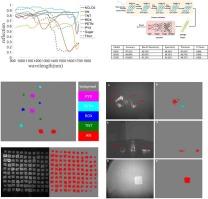基于近红外高光谱成像和卷积神经网络的危险品隔离识别。
IF 4.3
2区 化学
Q1 SPECTROSCOPY
Spectrochimica Acta Part A: Molecular and Biomolecular Spectroscopy
Pub Date : 2024-10-28
DOI:10.1016/j.saa.2024.125311
引用次数: 0
摘要
近红外(NIR)高光谱成像技术能够以非破坏性方式对危险材料进行快速、非接触式成像,并根据光谱反射信息进行分析。然而,使用传统方法很难识别光谱反射特征不明显的危险材料。本研究利用自建的近红外高光谱成像系统,提出了一种新方法。通过使用卷积神经网络(CNN),可以快速完成高通量光谱筛查,在空间点标记可疑光谱。与 SVM 和 KNN 方法相比,优化后的 CNN 表现出了卓越的性能(准确率 91.08%、召回率 91.15%、特异性 91.62%、精确度 90.17%、F1 分数 0.924)。我们的研究包括多任务验证测试,结果显示硝酸铵和三硝基甲苯的灵敏度为 10 mg/cm2,能够同时识别 100 多个目标。通过模拟真实世界的场景,我们成功检测到了散落在地面上的危险化学品,并准确识别了玻璃和薄塑料制品中的这些危险材料。即使在衣服遮挡视线的情况下,我们仍能正确识别危险化学品并生成相应的警告图像。即使在复杂的背景下,我们的系统也能表现出精确的识别能力。这种方法为识别和定位危险化学品提供了准确、快速的解决方案,为下一步非接触、远距离定量测定化学品浓度奠定了坚实的基础。这项研究强调了 CNN 在非接触、远距离分类和识别危险材料方面的有效应用,为进一步的科学和工程应用铺平了道路。本文章由计算机程序翻译,如有差异,请以英文原文为准。

Stand-off hazardous materials identification based on near-infrared hyperspectral imaging combined with convolutional neural network
Near-infrared (NIR) hyperspectral imaging enables rapid, non-contact imaging of hazardous materials in a non-destructive manner, allowing for analysis based on spectral reflection information. However, using traditional methods, it is challenging to identify hazardous materials with less distinct spectral reflection features. This study utilizes a self-built NIR hyperspectral imaging system and proposes a new approach. Using a convolutional neural network (CNN), This allows for the rapid completion of high-throughput spectral screening, marking suspicious spectra at spatial points. we sophisticatedly classified six hazardous material types, generating impactful warning images. The optimized CNN demonstrated superior performance (accuracy 91.08 %, recall 91.15 %, specificity 91.62 %, precision 90.17 %, and 0.924 F1 score) compared to SVM and KNN methods. Our study included multitask validation tests, revealing a sensitive detection of 10 mg/cm2 for ammonium nitrate and trinitrotoluene, capable of identifying over 100 targets simultaneously. By simulating real-world scenarios, we successfully detected hazardous chemicals scattered on the ground and accurately identified these hazardous materials in glass and thin plastic products. Even in situations where clothing obstructed the view, we could still correctly identify hazardous chemicals and generate corresponding warning images. Our system demonstrated precise identification capabilities even amidst complex backgrounds. This method provides an accurate and rapid solution for identifying and locating hazardous chemicals, laying a strong foundation for the next steps in non-contact, long-distance quantitative determination of chemical concentrations. This study highlights the effective application of CNN in non-contact, long-distance classification, and recognition of hazardous materials, paving the way for further scientific and engineering applications.
求助全文
通过发布文献求助,成功后即可免费获取论文全文。
去求助
来源期刊
CiteScore
8.40
自引率
11.40%
发文量
1364
审稿时长
40 days
期刊介绍:
Spectrochimica Acta, Part A: Molecular and Biomolecular Spectroscopy (SAA) is an interdisciplinary journal which spans from basic to applied aspects of optical spectroscopy in chemistry, medicine, biology, and materials science.
The journal publishes original scientific papers that feature high-quality spectroscopic data and analysis. From the broad range of optical spectroscopies, the emphasis is on electronic, vibrational or rotational spectra of molecules, rather than on spectroscopy based on magnetic moments.
Criteria for publication in SAA are novelty, uniqueness, and outstanding quality. Routine applications of spectroscopic techniques and computational methods are not appropriate.
Topics of particular interest of Spectrochimica Acta Part A include, but are not limited to:
Spectroscopy and dynamics of bioanalytical, biomedical, environmental, and atmospheric sciences,
Novel experimental techniques or instrumentation for molecular spectroscopy,
Novel theoretical and computational methods,
Novel applications in photochemistry and photobiology,
Novel interpretational approaches as well as advances in data analysis based on electronic or vibrational spectroscopy.

 求助内容:
求助内容: 应助结果提醒方式:
应助结果提醒方式:


